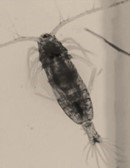This week marks “Research Week” on our blog and we will be highlighting marine debris research projects throughout the week! Research is an important part of addressing marine debris, as we can only effectively address it by understanding the problem the best we can.
By: Amy NS Siuda (Eckerd College), Kara Lavender Law (Sea Education Association), and Tony Andrady (Helix Science), Guest Bloggers and Principal Investigators for the Research Project “Investigating the Influence of Microplastics (and contaminants) on the Grazing Behavior of Copepods”
Can the tiniest plastic particles in the ocean introduce contaminants to the food web? This very question was at the heart of our recent research project, funded by the NOAA Marine Debris Program. As a first step to answering this question, we proposed to test whether microscopic copepods, the most abundant multicellular organisms in the ocean, would eat contaminated plastic particles.
Microplastic debris (less than 5mm) can originate from the likes of facial and body washes in the form of “microbeads,” or may start as larger, more recognizable, objects that break down into smaller and smaller pieces over time. Microscopic plastic particles can be as small as the single-celled algae that form the base of the marine food web (30 times smaller than a grain of salt!) and which are the primary diet for copepods.

Unfortunately, this plastic debris is often contaminated with toxic chemicals. Plastics can absorb and concentrate toxic pollutants present at trace levels in seawater, and some of the chemical additives mixed in during the manufacturing process can be toxic as well. When marine organisms ingest chemical-laden plastic pieces, some of the pollutants may be released within the gut of the animal and absorbed into body tissue. Although it is uncertain how much of these harmful chemicals enter marine animals due to ingestion of plastic debris in the ocean, laboratory experiments suggest there may be reason for concern.
Biological oceanographers often use simple bottle incubation experiments to isolate and observe interactions between microorganisms. Using this model, and using three common pollutants (nonylphenol, decabromodiphenyl ether, and dicholoro-diphenyl-tricholorethane—say that five times fast!) to contaminate select microbeads, we exposed individual copepods to one of four diets: microalgae, uncontaminated microplastic beads, contaminated microplastic beads, and a mixed diet of microalgae and contaminated microplastic beads.
Copepods in the wild tend to avoid eating naturally-toxic microalgae, so we were interested to learn if copepods exposed to a mixed diet would indiscriminately eat contaminated microbeads along with the algae, or if they would somehow sense and avoid eating contaminated microbeads altogether. If copepods eat the microbeads, there is potential for biological accumulation of contaminants that begins at the very base of the food web.
The experiments showed that copepods ate the contaminated plastic beads and apparently were not able to distinguish between an uncontaminated plastic bead and a highly contaminated bead. This was true of all three pollutants we tested.
The experiments also attempted to figure out the fraction of beads eaten by copepods when they were presented with a mixture of plastic beads (clean or contaminated) and algae, their staple food. However, unexpected methodological challenges complicated the data. In order to quantify the number of plastic beads and algae that were consumed during an experiment, we used automated particle counting based upon particle size. We discovered that the tiny polyethylene beads had a tendency to clump together. These clumps, together with biological debris from the algal cultures, obscured the particle size information needed to determine the number of plastic beads and algal cells that had been eaten. This result, while disappointing, revealed a previously unknown phenomenon (plastic particle clumping) and will inform future experimental designs.
Although the fraction of ingested microbeads couldn’t be determined, the discovery that copepods ate both contaminated plastics and clean plastics is an important finding. It suggests these organisms either cannot sense these particular contaminants on their food, or cannot selectively avoid food particles contaminated with toxic chemicals. Without these avoidance mechanisms, there may be toxicological effects for copepods exposed to contaminated plastics in the ocean.
For more information on this project, check out the project profile on the NOAA Marine Debris Program website and the Marine Debris Clearinghouse.
